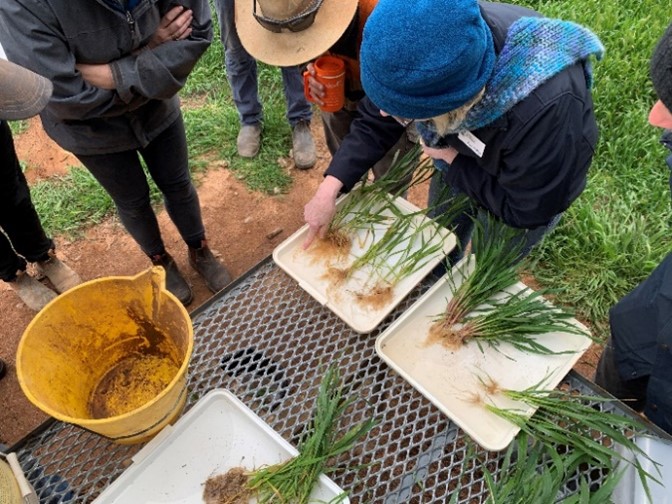Soilborne Pathogens
Resources collated for Soilborne Pathogens program
The national extension Soilborne Pathogens in Winter Cereals program is now complete.

Caption: MADFIG Soil Path Workshop live plant samples
Led by FarmLink and assisted by the Grower Group Alliance (GGA) in WA , the national extension Soilborne Pathogens in Winter Cereals program aimed to develop resources and manuals for growers through the targeted diagnosis of soilborne pathogens.
This GRDC investment was a national partnership between 12 grower groups and the leading plant pathologists from each state agency. The grower groups involved in WA were the Liebe Group, the West Midlands Group, Southern Dirt, the South East Premium Wheat Growers Association (SEPWA), the Stirlings to Coast Farmers and Merredin & Districts Farm Improvement Group (MADFIG).
The grower groups and pathologists delivered workshops, with interactive activities including hands-on learning with live, diseased plants (focussing on roots for identification and diagnosis) and the demonstration of some management approaches in affected paddocks, led by senior plant pathologists.
The Workshop participants were invited to bring samples from their paddocks where they suspected one or other soilborne pathogens to be present to learn how to recognise the most typical symptoms of the various diseases.
Senior plant pathologists demonstrated the correct way to sample plants and wash the roots, revealing root symptoms. Many soilborne pathogens do not cause obvious foliar (above ground) symptoms early in their infection cycle and examination of roots is far more revealing for diagnosis.
Grower groups were also tasked with establishing a series of large plot demonstration sites where various management methodologies were applied to assess impacts on disease expression and crop performance.
DNA testing was used at these sites to correctly determine the soil pathogens and the levels present.
Management options investigated included the use of seed dressing(s), crop rotation using break crops (where feasible), cultivation, soil amelioration and residue management among others, with observations of crop establishment, disease expression and crop yield used to measure and compare impacts from these treatments.
Growers were also advised of complicating factors that can apply to how soilborne pathogens impact cereal crops. These included:
- a change in how symptoms of soilborne diseases express given a shift to earlier sowing; and
- the ability of some pathogens co-exist and interact in ways that complicate visual identification of symptoms.
Resources developed and recognised within this project include:
The project has identified existing and produced several resources available to growers and advisers. Particularly accessible are a series of videos that highlight key lessons shared.
- Video series demonstrating sampling techniques targeting Rhizoctonia. Can be used for other pathogens, such as crown rot, take-all and root lesion nematodes as the application is similar.
- Podcast episode. This episode takes a closer look at the microscopic world of soil pathogens with Dr Dominie Wright, Senior Laboratory Scientist in DDLS and leader of the DPIRD plant diagnostic group.
- A general guide to sampling is also available online at:
- Videos that are more specific to individual pathogens have also been generated:
- A soilborne pathogen identification manual titled ‘A practical guide to identifying and managing cereal root diseases in South Australia’ is available through the South Australian Research and Development Institute (SARDI).
The project also generated its own website that can be viewed here.
Useful resources are also available on GRDC’s website at:

